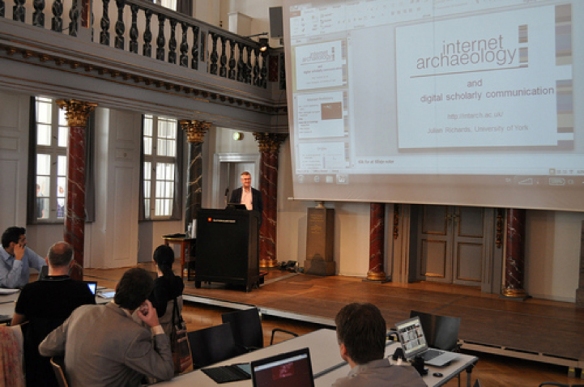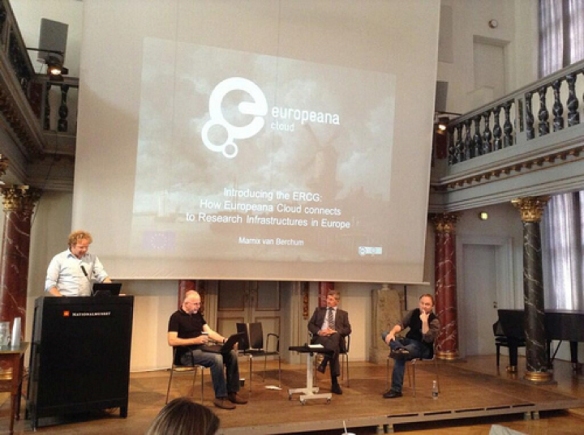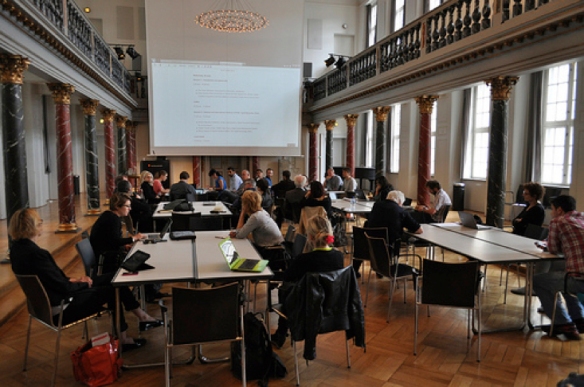Summary of proposal:
Our aim is to provide a single point of entry into the world of leading cultural heritage infrastructures and associated tools in Europe. As far as we know there is no easily accessible edited book of this nature that both focuses on key research projects and answers the major questions of the three editors.
The countries represented include Austria, Belgium, Denmark, Germany, Greece, Lithuania, Norway, Romania, United Kingdom, and related chapters from Canada and Australia. We are particularly pleased to include two proposed chapters from Professor Julian Richards of York University (Figure 1), and Professor Sean Ross, Dean of the iSchool, University of Toronto. They were the invited speakers, and have decades of experience in this field.
Figure 1: Invited Talk, Julian Richards, York University.
DIGHUMLAB Denmark, and the Digital Curation Unit Athens, ran a two-day workshop at the National Museum of Denmark, in Copenhagen, June 26-27, 2013 (Figures 1-4). There were approximately two-dozen presentations from around a dozen research organisations and European infrastructures, two invited international speakers (Professor Seamus Ross and Professor Julian Richards), and a final panel, which explored how research infrastructures dealing in digital cultural heritage could work more closely together. Various groups and future projects were kick-started from this workshop, including the ERCG (Europeana Researchers Coordination Group), which was set up to align the strategies of research infrastructures in the Social Sciences and Humanities (Figure 2).

Figure 2: Final Panel: Research infrastructures policy panel
Central topics of the workshop were
- Presentation of digital heritage tools and infrastructures (database, knowledge representation, analysis).
- GIS, 3D graphic reconstruction, high-end imaging.
- Ontology related to archives and database storage for material and visual culture, etc. and how best to share data and tools across European countries and partners.
- Database and infrastructure support for fieldwork (cf. issues of data collecting and representation, excavation and survey data management, recording “information at the trowel’s edge” to coin Ian Hodder, how to best process survey and long series datasets etc.).
- Discussion on further collaboration and how to influence EU policy in digital heritage-cultural heritage matters.
The mandate of the workshop was as follows:
“The workshop is open to all but we in particular invite participants drawn in the first instance from the DARIAH, ARIADNE, CENDARI and NeDiMAH and other EU cultural heritage networks. We envisage it will foster the growth of a community of practice in the field of digital heritage and digital humanities, leading to closer cooperation between participants and helping attendees develop tools and methods that can be used by the wider community.”
Figure 3: The Venue, National Museum of Denmark, Copenhagen.
We had a very strong turnout of participants, including keynote presentations by Prof. Seamus Ross, the University of Toronto iSchool’s Dean and Prof. Julian Richards, Professor at York University and Director of the Archaeology Data Service, and introducing innovative work from institutions and projects including: the Serious Games Interactive, the National Museum of Copenhagen, the Europeana Cloud project, DARIAH, DASISH, LARM, EHRI, ARIADNE, V-must (Virtual Museum Transnational Network), NEDIMAH, the Digital Curation Unit-Athena R.C., the Digital Repository of Ireland, and the Gunnerus Library in Trondheim (previously library of the Royal Norwegian Society of Sciences and Letters – DKNVS). We received about a dozen pre-workshop papers, and we are impressed with the quality and range of the work presented.
On this basis, we propose turning some of these papers into an edited volume, organized around the following themes:
- Scholarly information practices in cultural heritage.
- Requirements for digital tools and services.
- Corpora and digital collections.
- Digital infrastructures, architecture and tools.
- Digital cultural heritage, public communication and user experience, and
- Policy issues in cultural heritage infrastructure research and development.
